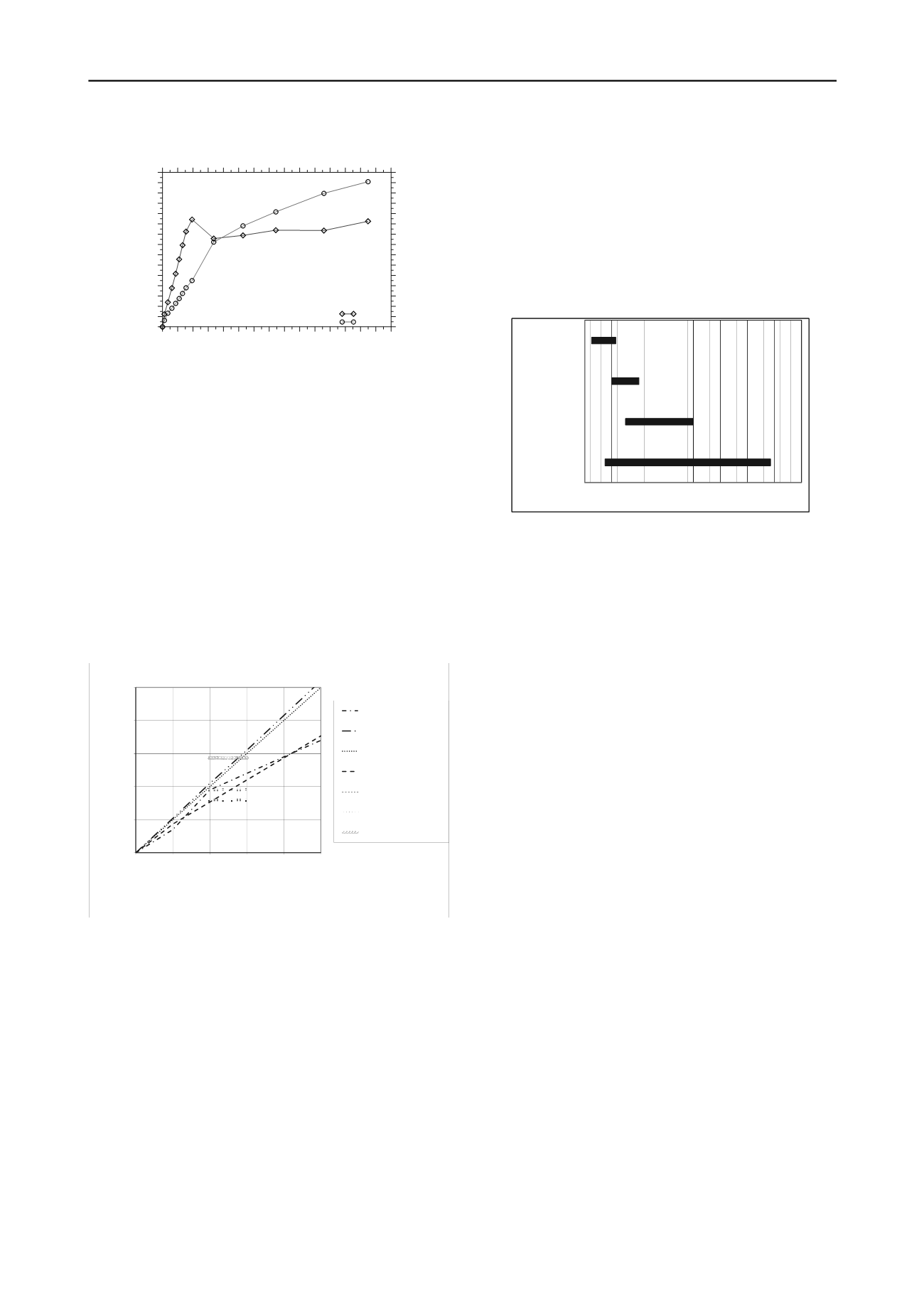
1921
Technical Committee 207 /
Comité technique 207
0 2 4 6 8 10 12 14 16 18 20 22 24 26 28 30
Nail Movement (mm)
0
10
20
30
40
50
60
70
80
90
100
110
120
130
140
150
Mobilised Skin Friction (kPa)
Legend:
Level 2 - 3
Level 3 - 4
0
10
20
30
40
50
60
70
80
90
100
110
120
130
140
150
0 2 4 6 8 10 12 14 16 18 20 22 24 26 28 30
Preliminary Soil Nail Pullout Test (Y-1/2)
Figure 13. Pull out test results, presented by
C. M. Chow and Y.C.
Tan
.
Lateral friction measurement results varied between 50 and
140 KPa. A conservative correlation for lateral friction of 5 x
SPT (in KPa) blowcount is also proposed.
These results are comparable with data presented in Ortigão
and Sayão (2004): for sands, approximate ratio between SPT
blowcount and lateral friction is around 5, and for clays, around
3,4.
M. Abramento et al.
presented results of pull out tests of
anchors for different grouting conditions and resulting lateral
friction between 80 KPa and 140 KPa. The soil where the
anchors were built has an approximate SPT blowcount between
20 and 30.
Finally, just for comparison, Décourt (1982) presented a
correlation between SPT blowcount and lateral friction for piles:
Lateral friction = 10 x (SPT / 3 + 1).
Figure 14 presents graphically the lateral frictions and
corresponding SPT blowcount values.
0
50
100
150
200
250
0
10
20
30
40
50
lateral friction (KPa)
SPT blowcount
Ortigão and Sayão - clay
Ortigão and Sayão - sand
Chow and Tan
Décourt
Abramento et al - 1
Abramento et al - 2
Abramento et al - 3
Figure 14. Lateral friction results, presented by
C. M. Chow and Y.C.
Tan
, including values published by Ortigão and Sayão (2004) and
Décourt (1982).
A. Gomes Correia et al.
present results of anchor tests in
medium dense sands, resulting in a lateral friction of 275 KPa.
Similar results and even higher lateral frictions are presented by
G. Vukotic et al.
for tests in different soils. Unfortunately, there
is no specific information available about the SPT blowcount,
but probably results will be well above the graphs presented in
Figure 14. Possibly, this difference occurs due the use of
pressure grouting.
Even considering the limitations of the SPT blowcount as
geotechnical design parameter, the correlations between the
SPT and lateral friction proposed by
C. M. Chow and Y.C. Tan
seem compatible with previously published results for soil nails.
Grout injection influence, in the author´s opinion, shall be
further investigated. Special anchor devices, like the one
presented by
C.di Prisco and F. Pisanò
work completely
different from cylindrical nails / anchors and further research is
necessary to allow reliable comparisons.
5.4 Soil mixing compressive strength
A. Gomes Correia et al.
present a case history where CSM
material, with a cement consumption of 600 kg/m
3
, was tested
and a minimum uniaxial compressive strength of 4 MPa was
obtained. Minimum E
50
values were 1 GPa. Unfortunately, few
results with information about this important design parameter
were presented. As complementary information, Figure 15
presents data published by Bilfinger et al, with results from
uniaxial compressive strength tests results in soil treated with jet
grouting technology.
0
2
4
6
8 10 12 14 16
Marine sand
Tertiary sediments
Marine clay
Organic clay PR
Uniaxial Compressive Strength (Mpa)
Figure 15. Uniaxial compressive strength, Bilfinger et al. (2012).
It can be seen that soil type has major influence on uniaxial
compressive strength, specially the organic matter content.
6 CONCLUSIONS
The technical papers included in this session cover a wide range
of topics. In items 3 and 5 some of these topics were discussed
in more detail.
Some conclusions may be drawn with relation to three areas:
Design
: No detailed design procedures were presented, but
some interesting conclusions can be drawn from the published
papers:
Numerical modeling is a common tool to model soil and
structure interaction;
Limit equilibrium analysis and beam-spring models
continue to be used in design practice;
The observational method, meaning, the use of
monitoring to control and, possibly, adjust the design, is
a widespread design “phylosophy”.
Construction
: Different construction techniques and
structures are discussed and presented:
Foundations: direct footings, caissons and suction
caissons, barretes and diphragm walls, soil treatment by
rigid inclusions;
Retaining structures: diphragm walls, secant pile walls,
sheet pile walls, soldier type walls, mixed in place
structures, anchored and nailed structures, reinforced
soil, cantilever and gravity walls.
Most of these construction techniques and structures are
already well known and the focus and innovation presented in
the papers are performance, size, depth and proximity to other
structures. Two exceptions are: soil treatment techniques, used
in different conditions and suction caissons.
Research
: Different research themes were presented, but one
of the important investigated issues is earth pressures for
different conditions. Another topic researched are mathematical
models associated to techniques to optimize design procedures,
and not to represent soil constitutive models.
REFERENCES
Bilfinger, W., da Silva, M.A.A.P., Rocha, H.C., Celestino, T.B. (2012)
Tunnels in São Paulo, in Soils of the Metropolitan Regions of São
Paulo and Curitiba, ABMS (in Portuguese)


